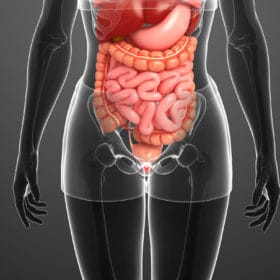Have you ever heard of Endometriosis heard of it? No? No wonder, because even though it is the second most common gynecological disease, most sufferers only hear about it for the first time after diagnosis. In this article, you will find out what endometriosis is, how you can recognize it, how it is treated and what you can do yourself.
What is endometriosis?
Endometriosis is a disease in which cells of the uterine lining colonize outside the uterus. Although it is a benign disease, it is often accompanied by severe pain and menstrual cramps. The proliferating tissue often affects the ovaries, intestines and pelvic tissue.
As part of the monthly cycle, tissue forms which, unlike the healthy uterine lining, is not excreted from the body. The tissue that remains in the body subsequently causes adhesions, cysts, bleeding and inflammation. Around 40,000 new cases occur every year in Germany alone.
What forms are there?
Depending on the location of the endometriosis, gynecologists differentiate between endometriosis genitalis interna, endometriosis genitalis externa and endometriosis extragenitalis.
- Endometriosis genitalis externa: This is the most common form of the disease. The growths are located outside the uterus in the area of the "small pelvis". This includes the so-called "Douglas space", the ovaries and the uterine retaining ligaments.
- Endometriosis genitalis interna: The growth occurs within the so-called myometrium. This is a muscle layer within the uterine wall. Endometriosis foci in the fallopian tube also belong to this sub-category.
- Endometriosis extragenitalis: In endometriosis extragenitalis, the disease affects areas outside the "small pelvis", e.g. in the bladder, ureters or intestines. In rare cases, endometriosis can also affect the spleen, lungs, bones or even the brain.
What are the symptoms of endometriosis?
Endometriosis is an insidious disease, which is why it is also known as the chameleon of gynecology. In practice, the symptoms vary in intensity from woman to woman. In some women, the symptoms are even completely absent.
To recognize the disease, you should look out for the following symptoms:
1 - Severe menstrual pain: The symptoms often manifest themselves in the form of cramps and pain during or shortly before menstruation. The pain is particularly severe if the growths are in the uterine muscles. In such cases, regular everyday life, including work, is out of the question.
2 - Pain during bowel movements and urination: In rarer cases, the disease is associated with pain during bowel movements or urination. This is due to the fact that the bowel and bladder are also affected. In some cases, depending on the menstrual cycle, blood may be present in the stool and urine.
3 - Pain during intercourse: Burning or cramp-like pain often occurs during intercourse. The pain is usually triggered by the affected ligaments of the uterus, which are irritated by the displacement of the organs during sexual intercourse.
4 - Other abdominal pain: However, pain can also occur independently of menstruation. This pain often radiates to the legs or back. It is often triggered by adhesions between the abdominal organs.
5 - Noticeable fatigue: Fatigue and exhaustion are caused by the inflammatory processes themselves as well as sleep disturbances due to the pain.
6 - Psychological symptoms: Apart from the physical strain, the disease is also accompanied by a not inconsiderable psychological burden. Stress reactions such as mood swings, increased irritability or depressive moods are often possible symptoms.
Causes and risk factors for endometriosis
Despite intensive scientific research, the exact cause is still unclear. One well-founded explanation is the so-called carry-over or transplantation theory. This theory states that mucosal cells from the uterus are transferred to other parts of the body via the bloodstream or so-called retrograde menstruation and accumulate there.
The metaplasia theory takes a different approach. According to this theory, the mucosal cells form directly on site in the affected region. Interesting: This theory explains why the disease can also occur in men in very rare cases.
In addition, there are possible risk factors such as malfunctions of the immune system, a disturbed hormone metabolism or genetic factors. Even though endometriosis often occurs in several women within a family, there is currently no evidence that it is directly hereditary.
Treatment and therapy
The treatment of the disease depends on the extent of the symptoms. In the case of mild symptoms where there are no major complaints, treatment is often not necessary at all. However, if there is persistent pain, organ dysfunction or if the disease prevents the desire to have children, treatment is advisable.
As a rule, treatment is limited to medication with the help of painkillers, progestin preparations or hormone preparations. In more serious cases, the disease is treated surgically. This is the case, for example, if the disease is the cause of infertility or if it leads to severe symptoms.
The aim of the operation is the targeted removal of the mucosal growths. The operation is usually performed as part of a laparoscopy using a laser, scalpel or electric current. Only in very rare cases is it still medically necessary to remove the ovaries or uterus.
What you can do yourself
You can also do a lot yourself to get the disease under control and alleviate the symptoms. In combination with medical therapy, the chances of success are good.
1 - Exercise regularly: gentle endurance sports in particular help to keep your metabolism healthy and going. Walking, easy walks and yoga are also ideal.
2 - Reduce stress: If you are under a lot of stress, you force your body to release stress hormones, which disrupt the hormone balance and therefore a number of metabolic processes. This in turn increases the risk of endometriosis. Basically, anything that reduces stress is allowed: be it massages, acupuncture, autogenic training, meditation, hot baths, sauna sessions or simply a good book and a cup of cocoa on the sofa.
3 - Pay attention to your diet: A healthy and balanced diet keeps your body in balance and builds up a protective shield against many illnesses. In particular, foods that counteract oxidative stress and inflammation are very useful. Omega-3 rich foods such as seeds, nuts and fatty sea fish such as salmon are the most important.
4 - Naturopathy: Some remedies from naturopathy are an excellent supplement to the actual treatment. Herbs such as monk's pepper, lady's mantle and evening primrose oil have been known for centuries for their pain-relieving effect on gynecological problems. CBD products have also become increasingly popular in recent years.




